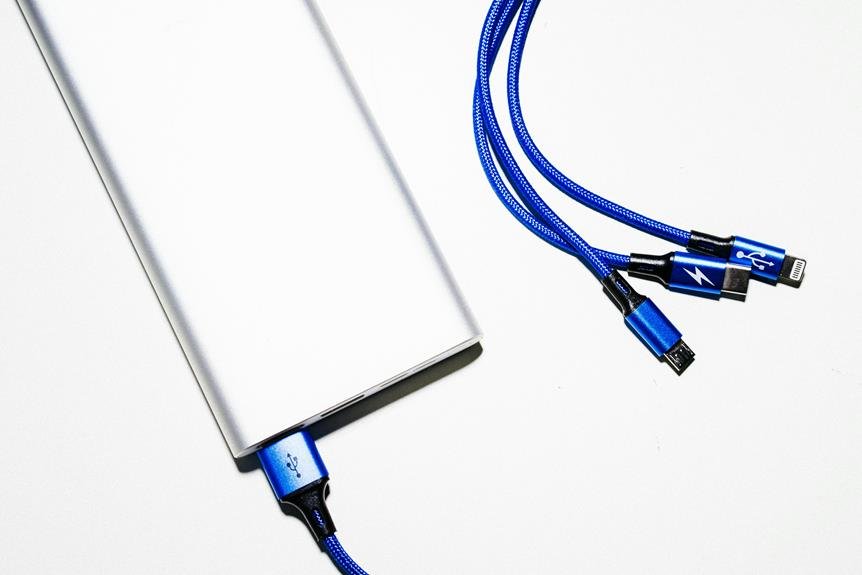Charging a power bank’s duration depends on several factors. First, check the capacity, measured in mAh; larger capacities take longer. Next, review input power specifications, usually listed in volts and amps, which affect charging efficiency. The type of charger you use plays a significant role—compatible fast-charging tech can drastically reduce times. Don’t overlook charging cable quality; robust, shorter cables transfer power more efficiently. Typically, a 10,000mAh power bank with a 2A input might take 5-6 hours. There are additional factors influencing the exact time. Continue exploring for a deeper understanding.
Power Bank Capacity
When evaluating a power bank’s capacity, you’ll need to assess its milliampere-hour (mAh) rating to determine how much charge it can store and deliver to your devices. The mAh rating directly impacts how many times you can recharge your gadgets without needing to recharge the power bank itself. For instance, a 10,000 mAh power bank can typically charge a smartphone with a 2,500 mAh battery about four times, assuming ideal conditions.
However, the real efficiency can be influenced by several factors, including the power bank’s efficiency and your device’s battery life. Power bank efficiency refers to how well the stored energy is converted into usable power for your devices. High-efficiency models, often supporting fast charging, minimize energy loss and maximize the actual charge delivered.
Charging speed is another vital aspect. Power banks with fast charging capabilities can greatly reduce the time needed to recharge your devices, offering you more freedom and convenience. To maximize battery life and guarantee reliable performance, look for power banks that balance high capacity with efficient energy conversion. Understanding these technical details empowers you to make informed decisions, ensuring your devices remain charged and functional whenever you need them.
Input Power Specifications
When evaluating input power specifications, you must consider both the voltage and current ratings, as these directly impact charging efficiency and compatibility. Pay attention to the charging port options available, such as USB-C or micro-USB, to guarantee they meet your device’s requirements. Properly matching these specifications will optimize the power bank’s performance and longevity.
Voltage and Current Ratings
Understanding the voltage and current ratings of your power bank is essential for maximizing performance and safety. The voltage (V) indicates the electrical potential difference, while the current (A) measures the flow of electric charge. Both parameters directly impact charging efficiency and power loss. When your power bank’s input specifications align with your charger’s output, you minimize power loss and enhance charging efficiency.
Fast charging technology has revolutionized how quickly you can power up your devices. However, not all power banks are compatible with fast charging. To achieve rapid charging, both your power bank and charger must support the same fast charging protocols, such as Qualcomm Quick Charge or USB Power Delivery. If mismatched, you might not experience the benefits of fast charging, and in some cases, it could even damage your power bank.
Moreover, always check the maximum input ratings of your power bank. Exceeding these ratings can lead to overheating or even permanent damage. Staying within the manufacturer’s specifications ensures longevity and peak performance. By understanding these technical aspects, you can make informed decisions that align with your need for speed and efficiency, freeing you from unnecessary downtime.
Charging Port Options
Choosing the right charging port options for your power bank is crucial to ensure peak input power specifications and compatibility with your devices. When assessing charging ports, you need to take into account the type, speed, and versatility for efficient and flexible charging.
First, identify the types of input ports available:
- USB-C: This port supports higher power delivery, often resulting in fast charging capabilities. It’s becoming the standard for modern devices due to its effectiveness and compatibility.
- Micro-USB: While still common, it is slower compared to USB-C and lacks the rapid charging capabilities that newer ports provide.
- Lightning: Mainly for Apple products, this port is more common if you’re using multiple device ecosystems.
Next, contemplate the input power specifications. Higher wattage input means quicker recharging times for your power bank. For example, a 5V/2A input will charge slower compared to a 9V/3A input.
Lastly, don’t disregard wireless charging options. While currently slower than wired methods, wireless charging offers unmatched convenience and freedom from cables, making it a feasible option depending on your lifestyle.
Charger Type
Frequently, the type of charger you use can greatly impact the efficiency and longevity of your power bank. Fast charging technologies, like Quick Charge or USB Power Delivery (USB PD), can reduce charging time to a large extent. These chargers provide higher voltage and current levels, allowing your power bank to recharge more quickly. However, make sure your power bank supports these technologies to fully benefit.
Wireless charging offers a different level of convenience, eliminating the need for cables. Yet, this method generally has a slower charging rate compared to wired options. If you prefer freedom from cables, wireless charging might be appealing, but be prepared for extended charging durations.
To provide a clearer comparison, consider the following:
| Charger Type | Charging Time |
|---|---|
| Standard USB Charger | Longest |
| Fast Charging (e.g., QC, USB PD) | Shortest |
| Wireless Charger | Moderate to Long |
| High-Wattage Wall Charger | Shorter |
Choosing the right charger type is important. High-wattage wall chargers can also speed up the process, though they must be compatible with your power bank’s specifications. By understanding these nuances, you can optimize your power bank’s charging time and guarantee its longevity, all while enjoying the freedom to choose the method that best suits your lifestyle.
Charging Cable Quality
When evaluating charging cable quality, consider the material composition and connector durability. High-quality materials like braided nylon can enhance lifespan and reduce wear. Additionally, robust connectors prevent frequent disconnections and guarantee efficient power transfer.
Cable Material Matters
High-quality charging cables, often crafted from strong materials like woven nylon or enhanced silicone, can greatly impact the efficiency and longevity of your power bank’s performance. When you’re aiming for peak charging efficiency, the cable length and material play a pivotal role. Shorter cables generally offer less resistance, thereby improving charging speed. On the other hand, longer cables can reduce charging effectiveness due to increased resistance over the extended length.
Material durability also plays a significant role. Woven nylon and enhanced silicone are not only sturdy but also flexible, reducing wear and tear over time. This ensures that your charging speed remains consistently high.
Consider the following points to maximize your charging setup:
- Cable Length: Opt for shorter cables to minimize resistance and enhance charging efficiency.
- Material Durability: Choose cables made from strong materials like woven nylon or enhanced silicone to maintain longevity and consistent charging speed.
- Quality Over Quantity: Invest in fewer high-quality cables rather than multiple lower-quality options to achieve superior performance.
Connector Durability
Maintaining connector durability is crucial for preserving the overall effectiveness and longevity of your charging cable. The connector’s stability directly impacts the charging speed and efficiency of your power bank. A sturdy connector guarantees that the electrical current flows consistently, reducing the risk of intermittent charging or slow power transfer. As a result, a resilient connector can greatly enhance your charging experience by minimizing downtime and maximizing the usefulness of your devices.
Port compatibility is another key factor in prolonging cable longevity. A cable that fits securely into your power bank’s port without excessive force or looseness will reduce wear and tear on both the cable and the port itself. Incompatible connectors can result in poor electrical contact, which not only reduces charging speed but also poses a risk of damaging your devices over time. Choose cables that are specifically tailored for your power bank’s port type to ensure top-notch performance.
Furthermore, investing in high-quality cables with reinforced connectors can offer long-term advantages. These cables are often designed to withstand frequent plugging and unplugging, thereby extending their lifespan. Essentially, prioritizing connector durability, stability, and port compatibility will guarantee efficient and dependable charging for your power bank.
Remaining Charge Level
Monitoring the remaining charge level of your power bank is vital for maintaining peak performance and making sure you don’t run out of power unexpectedly. Accurate charge indicators play a pivotal role in this. They allow you to estimate the best charging time needed and avoid overcharging, which can degrade battery health. Understanding the precision of your charge indicator helps you plan your power usage more effectively.
To improve your charging routine, consider the following:
- Check Charge Indicator Accuracy: Verify that your power bank’s charge indicator provides accurate readings. Some models may display imprecise levels, leading to ineffective charging and potential damage to the battery.
- Monitor Battery Health: Regularly checking the remaining charge level helps in preserving the battery’s health. An ideal charging time reduces strain on the battery, extending its lifespan and maintaining charging speed.
- Plan Charging Intervals: Knowing your power bank’s remaining charge allows you to plan your charging intervals effectively. This ensures you have ample power when needed, giving you the flexibility to stay connected without interruption.
Environmental Factors
While monitoring the remaining charge level is important, environmental factors greatly influence your power bank’s performance and longevity. Temperature impact is a significant concern; extreme temperatures—both hot and cold—can degrade the battery’s efficiency and lifespan. Ideally, you should charge your power bank in a moderate temperature range, around 20-25°C (68-77°F). Charging location also matters; a well-ventilated area will prevent overheating, which can lead to reduced charging efficiency and potential damage.
Humidity effect is another critical factor. High humidity levels can cause internal corrosion, affecting the power bank’s electronic components. It’s advisable to charge your device in a dry environment to mitigate this risk. Furthermore, sunlight exposure should be minimized. Direct sunlight can not only heat up the power bank but also cause thermal expansion and potential failure of internal components.
Safety Features
Frequently, power banks incorporate important safety features to protect both the device and the user from potential hazards. These features guarantee that your charging experience is both effective and secure, giving you the freedom to use your devices without worry.
First, prevention of overcharging is vital. This feature halts the power bank from drawing more current once it’s fully charged, which preserves battery health and extends device lifespan. Additionally, temperature regulation mechanisms prevent the device from overheating, ensuring safe operation under various conditions.
Second, short circuit protection guards against electrical faults that could cause malfunctions or even fires. This protection swiftly cuts off power to prevent any electrical mishaps. Furthermore, surge protection shields your power bank from unexpected voltage spikes, which can damage both the power bank and the connected devices.
To summarize, here are three important safety features you should look for in a power bank:
- Overcharging prevention and temperature regulation
- Short circuit protection
- Surge protection
These features are not mere add-ons but essential components that enhance the reliability and safety of your power bank. By confirming these safety mechanisms are in place, you can focus more on your activities and less on potential hazards.
Estimating Charging Time
Accurately estimating charging time for your power bank involves understanding its capacity, the charger’s output, and the efficiency of the charging process. To begin, you need to know the power bank’s capacity, measured in milliampere-hours (mAh). This figure directly influences how long it takes to recharge. A larger capacity, like 20,000 mAh, will take longer to charge than a smaller one, say 5,000 mAh.
Next, assess the charging speed, which is dictated by the charger’s output, typically measured in amperes (A). A standard 1A charger will charge more slowly compared to a 2A or 3A charger. For instance, if you use a 2A charger for a 10,000 mAh power bank, the theoretical charging time would be around 5 hours, assuming perfect efficiency.
However, efficiency losses, usually around 10-20%, should be factored in. Therefore, in real-world conditions, that 5-hour estimate might stretch to about 6 hours. Moreover, battery compatibility plays a role. Verify your charger and power bank are compatible to optimize the charging process.
Frequently Asked Questions
Can I Use My Power Bank While It’s Charging?
Yes, you can use your power bank while it’s charging, but it can reduce charging efficiency and affect battery longevity. It’s generally better to avoid simultaneous use to maintain peak performance and extend the battery’s lifespan.
How Do I Know When My Power Bank Is Fully Charged?
To know when your power bank’s fully charged, check the charging indicators. Typically, they’ll stop blinking or turn solid. Charging speed affects this, so faster chargers might show indicators sooner. You’re then free to roam!
Is It Safe to Leave My Power Bank Charging Overnight?
Regarding power bank safety, leaving it charging overnight isn’t perfect due to potential overheating and reduced charging efficiency. Modern power banks have safety features, but it’s best to avoid unnecessary risks for best performance and longevity.
Can I Charge Multiple Devices at Once With My Power Bank?
Yes, you can charge multiple devices at once with a power bank, depending on power bank compatibility. However, charging speed may decrease as more devices are connected, affecting overall efficiency and charging time for each device.
Does the Brand of the Power Bank Affect Charging Time?
Just like comparing different heroes’ strengths, brand comparison matters. Different brands offer varying charging efficiency due to their unique technologies. You’ll find some brands charge faster, thanks to superior components and optimized power management systems.



